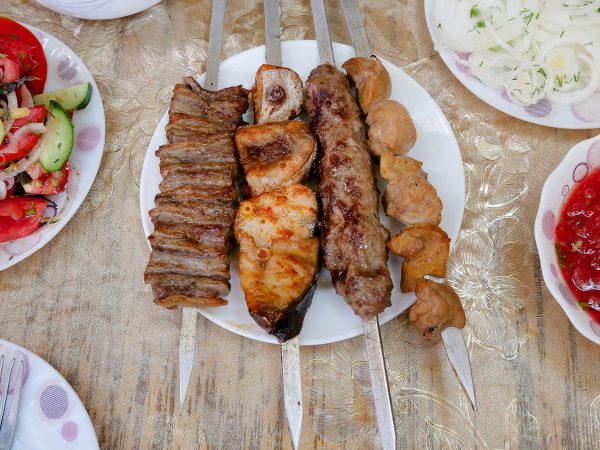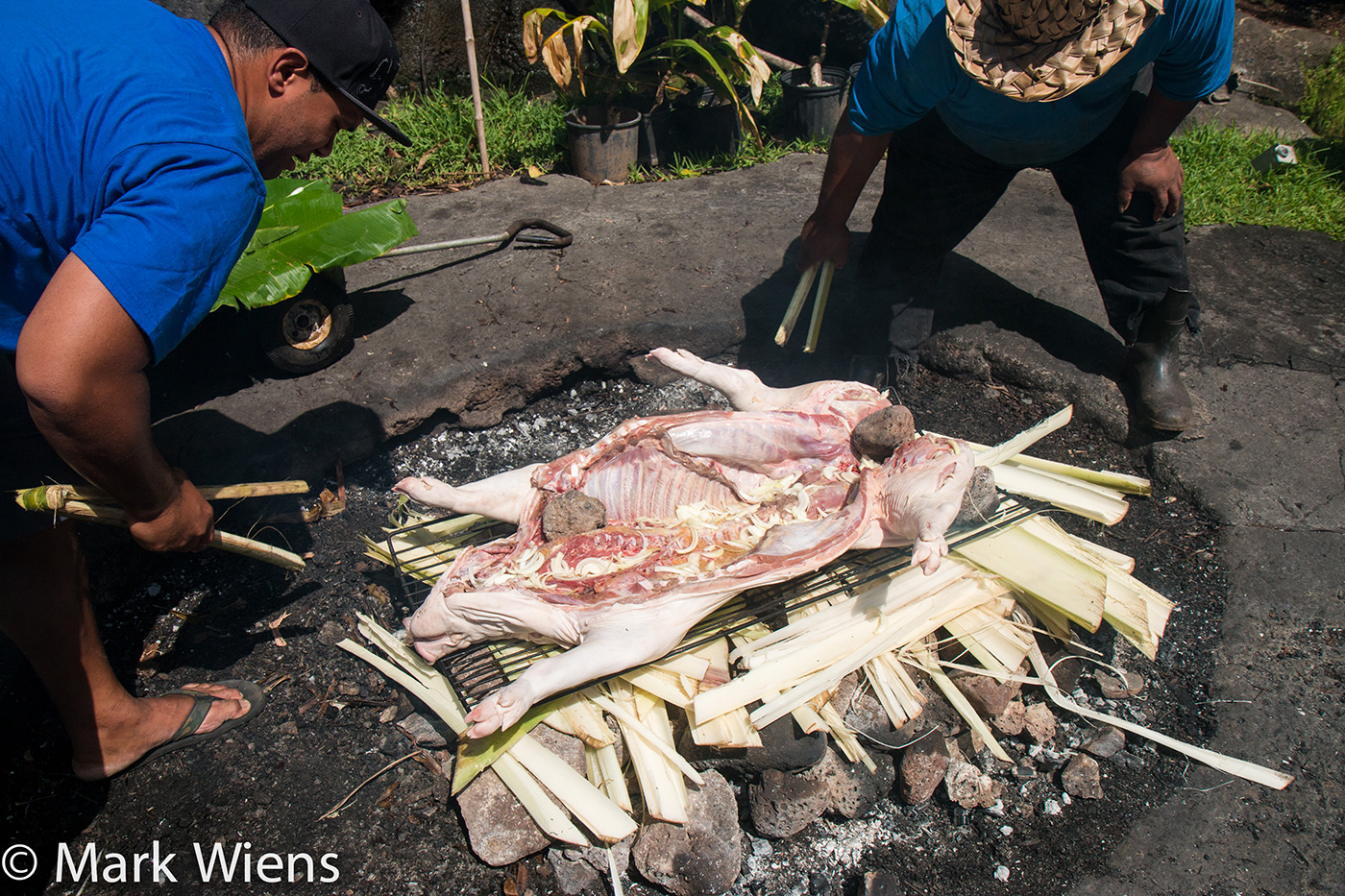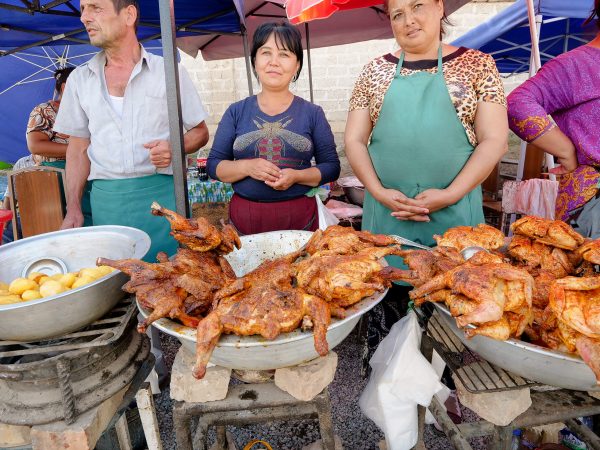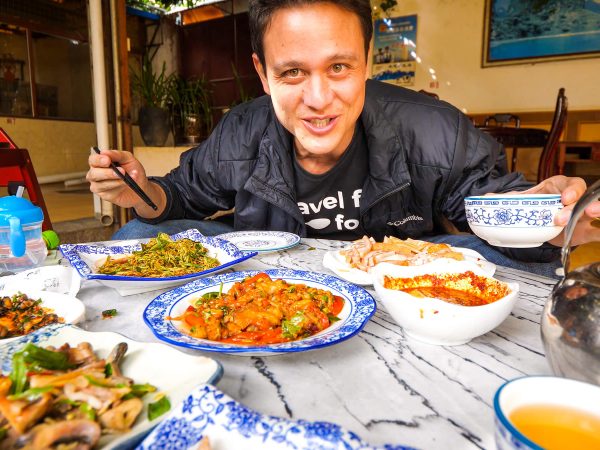

I’ve always been a huge fan of natural methods of cooking using heat and utensils all found in nature.
Like cooking food in poles of bamboo, or roasting food on a stick over fire.
In Polynesia, one of the traditional methods of cooking is in a hot-rock earth oven, using only natural cooking utensils found on the islands to prepare delicious feasts.
My wife and I were invited to the Polynesian Cultural Center for the luau, and not only did we get to enjoy the feast, but we were able to see them cook a pig in a Hawaiian imu as well.

What is an imu?
An imu is a Hawaiian traditional underground oven dug into the ground, and used to cook any variety of meat or seafood.
Throughout Polynesia, in countries like Samoa and Fiji, the underground-hot-rock cooking method is also used, though it’s prepared slightly different between each island, and is named differently.
River rocks are heated by burning wood, and once the rocks are hot, the burning wood is removed, and the meat is placed on top of the burning hot rocks. The meat is then covered by layers of banana leaves to hold in the steam and smoke, and the meat slow cooks for hours within the ground, seared by the hot rocks.
Now let’s go into a bit more details about how to cook a pig in an imu…

At the imu luau location at the Polynesian Cultural Center we met up with David, who kindly showed us how to set up an imu, and explained the importance of it in the Polynesian food culture.
This particular imu, David explained, is sort of a combination of a Hawaiian and Samoan style.
In Hawaii, typically an imu is dug a little deeper into the ground, whereas in Samoa it’s often mostly above ground, but cooked and prepared in a very similar fashion.
The first step in setting up an imu is to lay down a base of wood, and he used a type of ironwood, for its density and ability to burn and flame hot.

The river rocks were all piled on top of the base of wood, in the shape of a pyramid, ready to be lit.
Using a piece of cardboard, they lit the wood from the bottom, burning the wood in order to heat the rocks. Soon, the wood was blazing on fire, and the rocks were patiently sitting in the flames.

It took about 2 hours to heat the imu, so during that time, we walked around the Polynesian Cultural Center, and enjoyed the peace and quietness of the beautifully maintained gardens and villages.

2 hours later, we returned to the luau site, and the imu was heated to perfection and ready to begin cooking the pig.
The first thing they did was remove all the wood and burnt charcoal from the ironwood, which was still smoldering and smoking.
Get exclusive updates
Enter your email and I’ll send you the best travel food content.
As opposed to grilling, in an imu the wood and coals are only used to heat the rocks, not to cook any food.

After removing all the wood and charcoal that had formed, all that was left was the pile of rocks, which by this time were white hot, and almost looked like a mini volcano.
Standing near the pile of rocks, I could feel the heat radiating from it.
They spread out the rocks, just to make them more even, and to provide a flatter surface for the pig.

On top of the hot rocks, they shredded down a banana trunk, tore it into fibrous strips, and placed that immediately over the hot rocks to the sound of a hiss. This I’m sure toned down the hot rocks a bit, so the meat would not make direct contact and burn.
On top of the banana stump went a grill grate, and then the pig was laid on its hot rock bed.
The pig was seasoned with little more than some Hawaiian salt, and there was an onion sliced and sprinkled on top. Other than that, there was very little other seasoning.
Using natural tongs, giant chopsticks of folded over pieces of the banana trunk, they added a couple of the hot rocks onto the top the pig, just for a little bit of top heat.

The next step was to cover the pig with fresh green banana leaves.
Banana leaves are one of my favorite kitchen utensils, in Thailand they are frequently used to wrap food for cooking, in India they are often used as plates, and in Polynesia, among many other uses, they are used to cover an earth oven.
For an imu, you don’t need to just cook pig, you could cook any kind of meat in an imu – fish, mango raised mutton, turkey, anything you like.

Using an entire pile of leaves, they probably added about 20 layers or so, arranging them in a criss-cross system, making sure to fully cover the pig and the hot rocks below, and to make sure there weren’t any openings where too much smoke or steam could escape.
The banana leaves sealed in all that smoky goodness.

Finally, on went a layer of moist gunny sack, to keep the imu hydrated and preserve more of the steam and smoke.
Sometimes in Hawaii, or throughout Polynesia, they also use a tarp or just a piece of plastic to cover the very top of the imu to protect it from rain and to seal in the moisture of the oven.

Depending on what you’re cooking, and how big the meat is, will determine how long it will take to cook in an imu, but typically the meat is big, and usually an animal is whole, and slow cooked for hours.
They let the pig cook for about 6 hours this time.
With our spare time, as we waited for the evening luau, we spent the afternoon walking around the Polynesian Cultural Center and made our way from village to village eating different Polynesian foods and snacks along the way.
But I couldn’t wait for that pig!

The luau at the Polynesian Cultural Center started at 4:45 pm, and the first part of the ceremony was to remove the pig from the imu.
As soon as they took off the layers of banana leaves, I could immediately smell the aroma of the smoky pig.

The pig was carried on a tray to the back of the restaurant in order to be carved up and devoured.
I made sure to go straight to the pig, without passing the buffet line first – and if you go to the luau, you’ll probably want to head straight to the pig as well, because it goes fast.
I could actually see smoke pouring out of the nose of the pig, it was falling off the bone tender, and the skin was golden blackened on the outside, with juicy succulent meat on the inside.
The carvers could literally just pull off hunks of meat from the pig with ease.

Kalua pig
One of the most famous Hawaiian foods is kalua pig, pork that’s cooked in an imu.
I managed to get one of the pig cheeks, which was an incredibly delicious honor to receive.
The pig cheek, though quite fatty and greasy, was extraordinary good. The meat underneath was creamy and juicy, and the skin on the outside was crispy, lightly salted, and packed with flavor.
The plate of kalua pork butt was also very good, much leaner, but still extremely tender, and full of smokiness.
Both versions were good, but the pig cheek was the clear winner. But no matter what piece of the kalua pig you get, it’s going to taste incredible.

Throughout the evening luau, there was entertainment, including singing and dancing, and performances from around Polynesia.

Along with the kalua pig, the Polynesian Cultural Center luau included a full buffet.
Some of the main dishes included shoyu chicken, teriyaki beef, more kalua pig (not cooked in the imu), poi rolls, and some samples of other Hawaiian foods like poke and lomi salmon.

Overall, the food at the buffet was alright, not spectacular, but decent – it was a buffet catering to lots of people.
But for myself, it was really all about the kalua pig, cooked in the imu, that was the highlight of the luau for me!

If you have a few minutes, press play to watch the video below:
(If you can’t see the video, watch it here)
Conclusion
An imu is a traditional Hawaiian (and Polynesian) hot rock underground oven.
When I was in Hawaii, I was invited to the Polynesian Cultural Center to learn about how to prepare and cook a pig in an imu, and then to attend the evening luau to eat the pig.
The pork was incredibly flavorful, tender, juicy, and packed full of smokiness.
Along with eating the pig itself, what I enjoyed most about watching and learning how to cook in an imu, was the natural process of cooking, using rocks and leaves all found within nature right on the island.
The earth oven takes hours to heat, and hours to slow cook, and so it’s a leisure, social type of cooking and communal style of eating in Polynesia, and that’s something I really loved.
*I was invited to eat at the Polynesian Cultural Center luau, but as always, all opinions throughout this blog, thoughts, photos, and videos, are my own.
Get exclusive updates
Enter your email and I'll send you the best travel food content.



